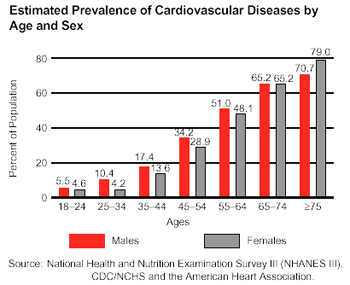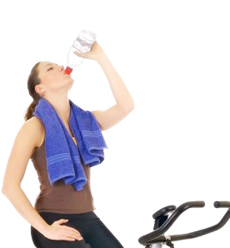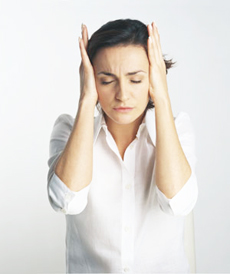|
|
|
 , ,
Font size |
Uprooting Top 10 Health Myths
The roots of International Women's Day began almost 150
years ago on March 8, 1857. On this date, one of the first real organized
actions of women's solidarity took place in New York City. Hundreds of women
staged a strike against the garment and textile factories in New York City,
protesting low wages, long working hours and inhumane working conditions.
International Women's Day
is a special day reserved to address the
issues and needs of women around the
world. In this article we catch up on
some Women health and fitness myths in
order to help them better understand
themselves.
 Myth #1: Young
Women don't have Coronary Disease. Myth #1: Young
Women don't have Coronary Disease.
Heart disease is the
number one killer of women in the United
States. It is also a leading cause of
disability among women. While it
is true that before the age of
menopause, women without risk
factors (family history,
diabetes,
high cholesterol, for example) do
have an advantage over men in rates of
heart disease. Younger female
patients with classic symptoms are
sometimes overlooked even by their
physicians, because of the myth. It is
key to know your family history and the
symptoms of heart disease.
Women right from the
early years should be
physically active, watch what
they're eating, reduce
saturated fats in their
diet, eat more fruits and
vegetables, whole grains and good fats,
and not smoke. Monitor their blood
pressure and cholesterol levels. It is
also important to check for diabetes if
you are
overweight,
obese or have close relatives with
premature coronary heart disease.
Heart disease
often has no
symptoms. But,
there are some
signs to watch
for. Chest or
arm pain or
discomfort can
be a symptom of
heart disease
and a warning
sign of a heart
attack.
Shortness of
breath (feeling
like you can't
get enough air),
dizziness,
nausea (feeling
sick to your
stomach),
abnormal
heartbeats, or
feeling very
tired also are
signs. Talk with
your doctor if
you're having
any of these
symptoms. Tell
your doctor that
you are
concerned about
your heart. Your
doctor will take
a medical
history, do a
physical exam,
and may order
tests.

 Myth
#2: Women should be more Concerned about
Breast Cancer than Heart Disease. Myth
#2: Women should be more Concerned about
Breast Cancer than Heart Disease.
A
healthy heart is vital for living
life to the full. The majority of women,
over 60 percent, identify breast cancer
as their greatest health concern, yet
heart disease and stroke claims more
than eighteen times the number of lives.
If your dad or brother
had a heart attack before age 55, or if
your mom or sister had one before age
65, you're more likely to develop heart
disease. This does not mean you will
have a heart attack. It means you should
take extra good care of your heart to
keep it healthy.
Cardiovascular disease,
or heart disease, includes many
conditions, but the most common type is
coronary artery disease, which is also
the most preventable. Coronary artery
disease involves blockages in the
arteries caused by plaque build up. If
this plaque progresses or ruptures,
heart attack or sudden death can result.
Hypertension, which is under the
umbrella of cardiovascular diseases, can
have many serious effects on the heart,
the blood vessels and the kidneys and,
if untreated, is a major cause of
stroke. It occurs when the blood
pressure is greater than 140/90 mm Hg.
Other types of heart disease include
diseases of the heart rhythm, which can
cause either a very slow heart rate or a
fast heart rate. One could also be born
with an abnormal heart, a condition
called congenital heart disease. And
heart failure occurs when the heart
can't pump properly because it has been
damaged or weakened, or because of high
blood pressure or hypertension.
 Myth
#3: Load up on Protein for Muscle Mass Myth
#3: Load up on Protein for Muscle Mass
 If the aim is to build
muscle mass, engage in a
strength training workout and
increase
caloric intake by as much as 500
calories . Not all of these additional
calories must come from
protein sources, especially if the
aim of the meal is to replenish what has
been utilized in exercise. About 60
percent of a weightlifting session is
fueled by fats, 35 percent by
carbohydrates, and 5 percent by
protein, according to Essentials of
Exercise Physiology. If the aim is to build
muscle mass, engage in a
strength training workout and
increase
caloric intake by as much as 500
calories . Not all of these additional
calories must come from
protein sources, especially if the
aim of the meal is to replenish what has
been utilized in exercise. About 60
percent of a weightlifting session is
fueled by fats, 35 percent by
carbohydrates, and 5 percent by
protein, according to Essentials of
Exercise Physiology.
Consuming more than 30
percent of food intake as protein may
cause a build up of ketones, which the
kidneys must flush out of the body. This
may stress the kidneys and the heart,
lead to dehydration, calcium loss from
the
bones, and a loss of muscle mass.
While protein is essential for building
muscle, skin, and hair, synthesizing
hormones, and blood clotting, it is
important to remember that even the most
avid athlete benefits most from a
balanced diet consisting of no more than
25 percent fat, 55 percent
carbohydrates, and 20 percent protein.
We don�t need a
pyramid for
protein; you can
simply follow
the fat pyramid
and you�ll
naturally get
the right type
and amount of
protein.
 Myth #4:
Sweating gets you in Shape Myth #4:
Sweating gets you in Shape
The basic rule of working
out is to avoid excessive sweating
whenever possible. Energy is required to
cool the system. This energy comes from
the activity of your sweat glands,
millions of them lying just under your
skin that use metabolic energy to
secrete sweat. This energy is drained
from the total energy you have at your
command to do the work of your body.
Your muscles have to share in this
energy in order to function properly. If
a disproportionate share of that energy
is used to secrete sweat, then there
isn�t enough left for your other bodily
functions. The amount of work you can do
lessens when sweat glands use energy.
When exhausted, they stop secreting, and
you are in peril of a heat stroke.
The second loss of energy when you are
over-heated is in the cardiovascular
system. When the skin gets hot, the
peripheral vessels leading to the skin
open. Blood supply rushes to the surface
of your body. This deprives the muscles
of the blood they need. The heart tries
to make up for the loss by pumping
harder. The load becomes so great that
if it is maintained for a prolonged
period you could collapse. Inducing
sweat is dangerous- and it makes no
contribution to fitness.
Sweating does make the
heart work harder, which is an objective
of a fitness workout, but it does so in
a hazardous manner. Sweating does burn
calories, but it is a dangerous way to
reduce weight.
 Myth #5:
Never Drink Water while Exercising Myth #5:
Never Drink Water while Exercising
 This is wrong. You
shouldn�t even wait until you are
thirsty. If you feel you are losing
water, you should immediately
replace it. And if you intend to
exercise the first thing in the morning,
you should drink a glass of water before
you start. This is wrong. You
shouldn�t even wait until you are
thirsty. If you feel you are losing
water, you should immediately
replace it. And if you intend to
exercise the first thing in the morning,
you should drink a glass of water before
you start.
The body cells depend on circulation in
order to get the energy they need, and
to get rid of their waste products. When
you become dehydrated, the fluids that
bathe the cells diminish. The cells
cannot function properly until it is
restored. When that happens, your
muscles cannot keep up the work they are
doing and your heart receives an added
strain. Part of the fluid you�ve lost is
blood fluid. This means that the heart
has to pump that many more times to
re-circulate the diminished supply of
blood.
 Myth #6:
Women and Men can Safely Drink the same Amount of Alcohol per Day. Myth #6:
Women and Men can Safely Drink the same Amount of Alcohol per Day.
The safe limit for women
is one drink a day, fewer than men's two
drinks. Researchers at the Harvard
School of Public Health have found that
women who are non drinkers have a 40
percent lower risk of getting breast
cancer than women who consume two to
five
alcoholic beverages a day. A woman's
cumulative lifetime risk is about one in
eight and women who consume more than
two drinks a day raise their risk to one
in six. Women who are lighter drinkers
(one per day) have a much smaller added
risk and that one drink a day can help
actually reduce the risk of heart
disease. A woman should evaluate her
risk factors for breast cancer and heart
disease before deciding about the
appropriate level of alcohol in her
diet.
 Myth #7:
I'll Lose Weight if I Eat Low-Fat Foods. Myth #7:
I'll Lose Weight if I Eat Low-Fat Foods.
 This widespread myth
explaining why women are eating less fat
yet getting fatter. National surveys
find that despite carving 7 percent of
the fat from our diets, the number of us
who are overweight has increased by 9
percent during the last 14 years. You
can put on pounds even if you eat
low-fat versions of your favourite
high-fat foods. Though you're consuming less fat, you may be eating more
calories. Remember, low-fat doesn't necessarily mean low-calorie This widespread myth
explaining why women are eating less fat
yet getting fatter. National surveys
find that despite carving 7 percent of
the fat from our diets, the number of us
who are overweight has increased by 9
percent during the last 14 years. You
can put on pounds even if you eat
low-fat versions of your favourite
high-fat foods. Though you're consuming less fat, you may be eating more
calories. Remember, low-fat doesn't necessarily mean low-calorie
Low-fat, not necessarily cumulates to
low-calorie For example, the difference
between one-half cup of vanilla ice
cream and one-half cup of low-fat
vanilla ice cream is only about 40
calories. But even if you save calories
by dishing up a 100-calorie, half-cup
serving of the low-fat version, you may
be tempted to eat more because it's
low-fat and too tasty to pass up. Eating
more equals more calories. By all means,
reduce the fat in your diet. But if
you're watching your weight, remember to
count calories � because calories still
count. The average woman needs between
1600 and 2000 calories a day. You can
figure out how many calories you need
each day by multiplying your weight (in
pounds) by 12.
 Myth#8:
I had one normal mammogram, so I don't need another one. Myth#8:
I had one normal mammogram, so I don't need another one.
One is not enough. Women
should have mammograms done as
recommended. Mammography is the most
advanced and cost effective way to
detect early breast cancer. It can
detect breast cancer when it is in its
earliest, most treatable stages.
However, approximately 15-20 percent of
all breast cancers will not be
identified by mammography alone. For
this reason, monthly
breast self-examination (BSE) and a
yearly physical exam also are
recommended as part of a complete breast
health program.
The American College of
Radiology and the American Cancer
Society recommend women between the ages
of 35 and 40 have a baseline mammogram;
women between 40 and 49 should have an
annual or biannual mammogram and should
consult their personal physicians about
their need for mammography; and women
over 50 should have a mammogram every
year.
 Myth#9:
Just because Headache is common doesn�t mean that it�s normal. Myth#9:
Just because Headache is common doesn�t mean that it�s normal.
 This is the most
significant
headache myth. This is the most
significant
headache myth.
Despite the out-dated stigma about
people with
migraine or other recurrent headache
being malingerers, weak, neurotic, or
having a mental illness, headache is a
real, legitimate, biologic syndrome that
can be prevented, treated, and managed.
Headaches can be
triggered or made more severe when
sufferers are exposed to specific
environmental factors, such as strong
odors like cigarette smoke or perfume.
Specific aspects of one's diet
(beverages, meals, snacks) also may
trigger headache. For example, low blood
sugar as seen with prolonged fasting or
extensive dieting may lead to increased
headaches.
For many, the
frequency and severity of headaches may
actually be a signal of how hectic and
stressful life may be for them.
Lifestyle changes can help reduce the
frequency and severity of headaches.
Here are some examples of lifestyle
changes that may improve headache
management:
-
Diet: Eat a healthy, balanced diet at
regular times. Long periods of fasting,
and dramatic swings in blood sugar
levels, may cause an increase in
headaches. Limit caffeine and smoking.
-
Exercise: Regular exercise is an important part of reducing headaches
and maintaining a healthy lifestyle.
-
Sleep: Fatigue and sleep deprivation may lead to an increase in
headaches. Excessive sleep may trigger headaches.
-
Calendars: Track the frequency and severity of headaches by keeping a
calendar. This will help monitor lifestyle factors that contribute to
headaches.
 Myth#10:
Food Eaten late at Night is more Fattening. Myth#10:
Food Eaten late at Night is more Fattening.
Many diets tell you not to eat
after a certain time in the evening in
the belief that the body will store more
fat because it is not burned off with
any activity. However, a study at the
Dunn Nutrition Centre in Cambridge
suggests otherwise. Volunteers were
placed in a whole body calorimeter
(which measures calories burned and
stored) and were fed with a large lunch
and small evening meal for one test
period, then a small lunch and large
evening meal during a second test
period. The results revealed the large
meal eaten late at night did not make
the body store more fat � it's the total
amount eaten in a 24-hour period that's
important, It is true that people who
skip meals during the day, then eat
loads in the evening are more likely to
be overweight than those who eat
regularly throughout the day. This may
be because eating
regular meals helps people regulate
their appetite and overall food intake.
Take care & Happy
Woman's Day
Dated 07 March 2012
Related Links
|
|
|
|
|









